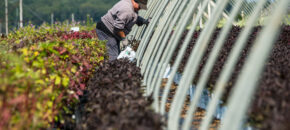Anthracnose and Alternaria leaf blight can become problematic in cucurbit crops during long periods of wet, humid weather. Both can cause significant losses if not controlled properly. With the production season in full swing, now is a good time to review a few of these important diseases.
Continue reading...Preparing for cucurbit downy mildew in 2024
In 2004, cucurbit downy mildew re-emerged in the US with a vengeance causing significant losses in cucurbit production. In most years prior to this, concern for CDM control was minimal, since the pathogen arrived late in the growing season (in more northern regions), or the pathogen caused little damage, or never appeared. After 2004, with […]
Continue reading...Vegetable IPM Update 6/05/24
Sweet Corn European corn borer (ECB) moth captures are fairly steady at low levels in northern and central county light traps. Feeding has been detected in some whorl and pretassel stage plantings where scouting is occurring. Thus far, feeding has been mostly in single digit percentages, although one planting in Somerset County approached 20% plants […]
Continue reading...Tree Fruit IPM Report June 6, 2024
Peach: Bacterial Spot: Copper formulations should be used starting at petal fall to suppress bacterial spot. Generally we recommend starting at 0.5 ozs metallic copper and gradually lowering the rate as the season progresses. The rate applied will depend on the formulation. Dr. Lalancette published a chart listing common copper formulations and rates for peach […]
Continue reading...Cucurbit powdery mildew control in 2024
Cucurbit powdery mildew (CPM), caused by Podosphaera xanthii, is one the most important diseases of cucurbit crops throughout the world. The pathogen is an obligate parasite, just like cucurbit downy mildew, meaning it needs a living host in order to survive. In northern regions that have a killing frost in the fall the pathogen will […]
Continue reading...TONIGHT: Webinar on Heat Stress in Agriculture

The Rutgers Farm Health and Safety Working Group, in partnership with New Jersey Farm Bureau, invites you to a two-part webinar series titled “Don’t Sweat Heat Stress in Agriculture”. The first webinar will take place tonight! Wednesday, June 5 from 7:00-8:00 PM An introduction to heat stress issues in agriculture. We will also share tools […]
Continue reading...